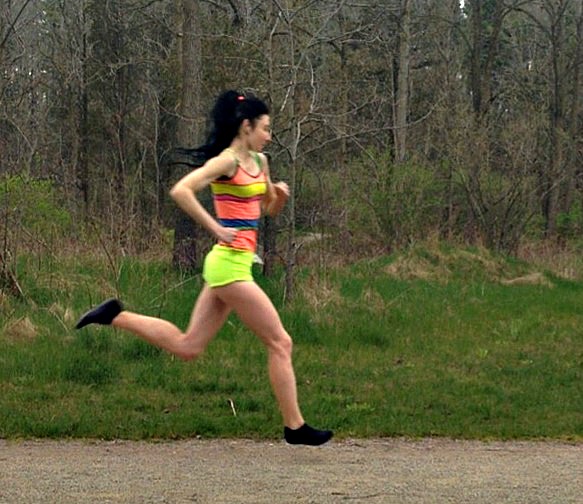When learning a new style of running, I think its natural for runners to start off slow by running super slow. For example, many runners run very slow when learning forefoot running, but after looking into the research, the reason that running slow isn’t a good thing is clear: it feels uncomfortable and its mechanically inefficient. So, running fast is better than running slow when forefoot running and I’ll give you more detailed reasons why.

- Many forefoot running technique learners report that running on the forefoot feels unnatural and uncomfortable when the real problem is they are running too slow. The best way to fix this is by running fast.
Forefoot Running Technique More Comfortable Running Fast
A study by Ardigo et al., compared the metabolic aspects in competitive heel strike runners who adopted the forefoot running technique. Subjects complained that the forefoot running technique felt unnatural at slower speeds (4.5mph – 5.5mph) and gave the visual impression of a kind of ‘standing still running’.
However, subjects reported that the forefoot running technique felt natural and smoother when running at faster speeds (9 mph to 11 mph).
The researchers did not provide an explanation on the perceptual variation associated with the forefoot running technique at certain speeds.
However, the ‘smooth and natural’ feeling reported by the subjects reflects the body’s natural tendency to land with a forefoot strike as running speed increases. Other work has shown that heel strikers almost instantaneously adopted a forefoot strike while sprinting.
The researchers also suggested that when running at faster speeds, the heel strike to forefoot strike transition may be an energy-saving mechanism of the body.
Why the Body Ditches the Heel Strike When Running Fast
As speed increases during heel strike running, so do 2 forces : a vertical impact peak (occurs at heel strike) and a single impact peak (occurs at mid-support phase of heel striking). In addition, the tibia (shin bone) aligns in front of the body during heel strike running at faster running speeds (Nigg et al, 1987), which may increase brake forces on the shins. Nonetheless, these forces are either low or eliminated in the forefoot running technique.
Therefore, it would make sense for the body to adopt a forefoot strike to reduce impact and thus avoid pain and injury when running at faster speeds.
One aspect of forefoot running that reduces impact is higher step frequency. In forefoot running, as speed increases, the feet spend less time on the ground. Less ground-contact in forefoot running exposes the body to less force.
In contrast, heel strike running results in longer ground-contact time whereby the longer the foot is on the ground, the higher the force exerted between the body and the ground.
The Take Home Message
If you want to run faster, but are a heel striker, switching to the forefoot running technique is a sensible path since not only sprinters, but the top marathoners in the world run on their forefoot, not their heels.
More From Run Forefoot:
- Forefoot Running Eliminates Shin Splints
- Running on the Forefoot Saves the Knees
- Forefoot Running Shoes
References:
Ardigo et al. (1995). Metabolic and mechanical aspects of foot landing type, forefoot and rearfoot strike, in human running. Acta Physiol Scand, 155(1):17-22.
Nigg B, Bahlsen H, Luethi S, Stokes S. The influence of running velocity and midsole hardness on external impact forces in heel-toe running. J Biomech. 1987;20(10):951–9.
Bretta Riches
BSc Neurobiology; MSc Biomechanics candidate, ultra minimalist runner & founder of RunForefoot. I was a heel striker, always injured. I was inspired by the great Tirunesh Dibaba to try forefoot running. Now, I'm injury free. This is why I launched Run Forefoot, to advocate the health & performance benefits of forefoot running and to raise awareness on the dangers of heel striking, because the world needs to know.
Latest posts by Bretta Riches (see all)
- Can You Run In Barefoot Shoes? Yes, But DON’T Heel Strike! - 21/07/2024
- Why Cushioned Running Shoes Are Really Bad for Your Feet - 19/07/2024
- Do Cushioned Running Shoes Cause Injuries? - 17/07/2024

Leave a Reply